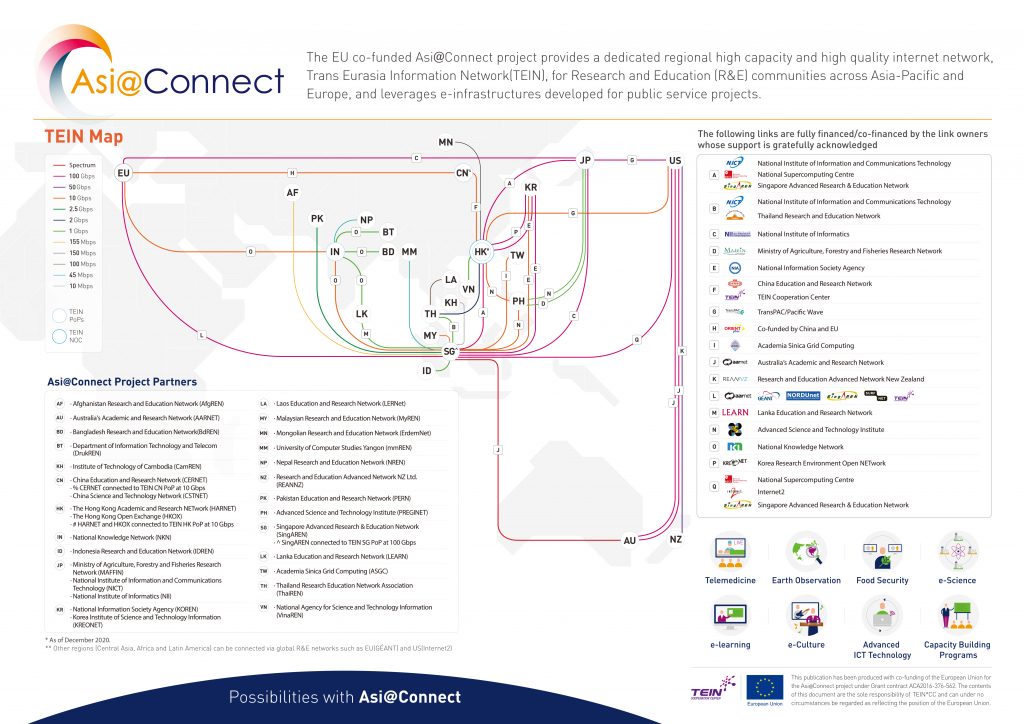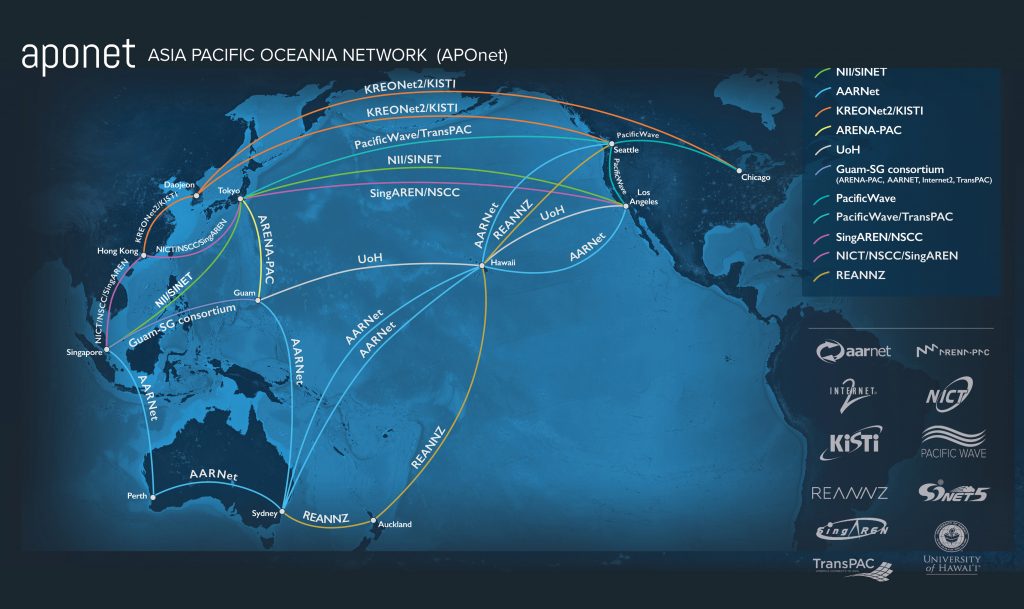
Quick question: How did the Internet arrive in the Asia Pacific?
Those with a passing knowledge of Internet history will know that the early stages of the Internet began in the US with the Advanced Research Projects Agency (ARPANET), and from there it made its way around the world.
But that spread didn’t happen on its own. Before ISPs could start providing the Asia Pacific with Internet access on a commercial basis, there had to be some ‘Internet’ to provide.
This was first provided by Research and Education Networks (RENs, or NRENs when they’re the official national REN). These RENs were pioneers of the Internet and were set up by universities and researchers, with government support.
How have RENs evolved as the Internet was commercialized, and what’s happening with them today?
The first players to emerge
Before there were any commercial Internet operations in the Asia Pacific, there was the Pacific Communications Network (PACCOM). Run by the University of Hawaii and funded by the US government via the National Aeronautics and Space Administration (NASA), as of 1989 (with additional funding in 1991 from the National Science Foundation and the Department of Energy), PACCOM was how the first connections to Australia, Hong Kong, Japan, Korea, and New Zealand were established.
Each economy had their respective organization that helped connect via PACCOM. In Australia, the Australian Academic and Research Network (AARNET) was the key player, Japan had the WIDE Project, and The Chinese University of Hong Kong (CUHK) pitched in at their end.
These organizations were not commercial entities, as the Internet would not be commercialized in the Asia Pacific until a few years later — the first Internet connections in Hong Kong, for example, arrived in 1991 but commercial Internet access would not be launched until 1993.
These were just some of the Asia Pacific’s many NRENs. In the years that followed, many more NRENs and RENs took shape and helped play an important role in maintaining the Internet. Multinational RENs (such as TEIN) and coordination groups like APAN also emerged as the REN ecosystem grew.
How are RENs still relevant today?
RENs brought the Internet to many economies before commercial providers helped expand the Internet to what we experience today. But research networks still play a crucial role.
Large parts of the Internet today are run by not-for-profit organizations; it isn’t all profitable. And those parts of the Internet that operate outside of commercial frameworks also help enable the profitable elements of the Internet.
Read: Open Internet, open standards, and why they matter
Similar principles can be applied in the context of RENs. Valuable research isn’t always profitable, but it is important. For example, CERN’s large hadron collider (LHC) generates huge amounts of data which researchers around the world need to be able to access for analysis. It’s often a race to the best scientific findings, but the amounts of data involved are enormous. LHC experiments produce about 90 petabytes of data per year. It would not be feasible to transfer this amount of data via commercial ISPs in a fast and cost-effective way.
There are also low-latency high-bandwidth requirements of certain advanced applications such as super-high-definition and/or three-dimensional video conferencing for medical purposes that can only be fulfilled by RENs.
It’s not just research though, RENs help secure and develop the Internet in many different ways.
In Sri Lanka, for example, the NREN is helping its members mitigate cybersecurity risks.
Hong Kong’s Internet Exchange Point (HKIX) was established in 1995 and is still being operated by CUHK to provide faster, cheaper, and easier interconnections among commercial providers as well as RENs.
When COVID-19 emerged and spread around the world, RENs swung into action to provide access to research data to facilitate collaboration. This was due to the immediacy of the problem and because travel restrictions meant some forms of research collaboration, such as physical conferences, faced obstacles.
From education, to cybersecurity, infrastructure, research and fostering best practices, RENs continue to play a vital role in supporting the development of the Internet and society.
However, as more RENs operate at large scale, it has become necessary for them to coordinate their activities. In many cases, a multinational REN is there to link up other RENs into a larger more powerful network.
Multinational RENs to connect other RENs
One of the larger RENs in the Asia Pacific today is the Trans-Eurasia Information Network (TEIN), which operates Asi@Connect. The project started out as an Asia-Europe Meeting (ASEM) initiative in 2001 and became TEIN in 2004. Operating out of Korea, TEIN’s goal is to connect the various elements of Internet infrastructure between Europe and Asia. TEIN also now connects to the US via Japan.
We can think of the Asi@Connect project as connecting the various smaller networks to each other and boosting their speed and effectiveness along the way.

Essentially, this network is a REN comprising many participating RENs and NRENs. Each joined for their own reasons, but together they help boost the connectivity of the whole network.
Early networks included Hong Kong, Singapore, and Japan — they became key nodes connecting other networks, due also in part to their geography and proximity to those networks.
The latest multinational REN initiative to emerge is APOnet, which links 11 NRENs and RENs, established in June. With important scientific discoveries being made by teams collaborating around the world, the new REN initiative will accelerate the sharing of data among geographically distant researchers and improve network resilience.

APNIC is indirectly participating in APOnet via ARENA-PAC, which is a project funded by the Asia Pacific Internet Development Trust (APIDT). APIDT is a joint initiative of the WIDE Project and APNIC.
WIDE Project founder, Jun Murai, says that a key goal of ARENA-PAC is to become an ‘artery’ of the future Internet. ARENA-PAC was developed from existing international submarine cable connections and is operated by the WIDE Project.
With the establishment of APOnet, ARENA-PAC will be able to connect researchers more directly.
Future growth
There are still economies in Asia that don’t have their own NREN, and some without extensive REN coverage. However, there are ongoing efforts to help connect these locations, including projects the APNIC Foundation is involved in.
SOI Asia was launched in 2001 as a collaborative platform for inter-university educational programs in Asia. It uses satellite-based Internet technologies to provide connectivity that is less expensive, easier to deploy, and more feasible for universities located in regions where the Internet environment is insufficiently developed.
The project also conducts research and seeks to develop the necessary technologies needed for skills development among the Internet technical community in Asia.
The related AI3 is an international research consortium linking universities and research institutes in the Asian region with researchers working to develop and deploy Internet technologies over satellite links, such as IPv6 and WWW caching.
Starting this year, these initiatives are being supported by the APNIC Foundation.
In addition, a new initiative, the Satellite Arterial Research and Educational Network in Asia-Pacific (SARENA-PAC) research and development project seeks to build on the previous achievements of AI3 by improving the resilience of satellite connectivity, particularly in times of disaster. This will be achieved by a non-terrestrial network in the Asia Pacific using several possible satellite technologies, such as High-Throughput Satellites (HTS) and/or Low Earth Orbit (LEO) satellites, along with work on an emergency-ready, disaster response network.
With continuing rapid growth in international research collaborations, the future relevance of the REN pioneers of the Internet shows no sign of decline.
The views expressed by the authors of this blog are their own and do not necessarily reflect the views of APNIC. Please note a Code of Conduct applies to this blog.

Here are some early notes I wrote up from the 1991 PACCOM meeting which contains a brief summary of the state of Asia Pacific NRENS at the time: http://wwcm.synology.me/Archives/CC%204.72%20AARNet%2019910526%20PACCOM%20'91%20Meeting%20Notes.pdf